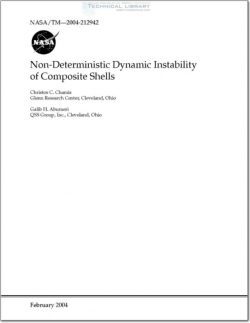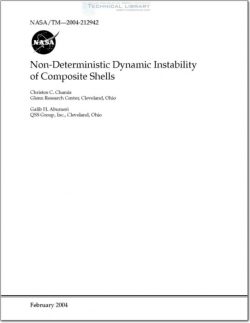NASA-TM-2004-212642

- Version
- 167 Downloads
- 1,007.84 KB File Size
- 1 File Count
- August 18, 2016 Create Date
- August 18, 2016 Last Updated
Non Deterministic Dynamic Instability of Composite Shells

A computationally effective method is described to evaluate the non—deterministic dynamic instability
(probabilistic dynamic buckling) of thin composite shells. The method is a judicious combination of
available computer codes for finite element, composite mechanics and probabilistic structural analysis.
The solution method is incrementally updated Lagrangian. It is illustrated by applying it to thin composite
cylindrical shell subjected to dynamic loads. Both deterministic and probabilistic buckling loads are
evaluated to demonstrate the effectiveness of the method. A universal plot is obtained for the specific
shell that can be used to approximate buckling loads for different load rates and different probability
levels. Results from this plot show that the faster the rate, the higher the buckling load and the shorter the
time. The lower the probability, the lower is the buckling load for a specific time. Probabilistic sensitivity
results show that the ply thickness, the fiber volume ratio and the fiber longitudinal modulus, dynamic
load and loading rate are the dominant uncertainties in that order.
Shell structures are in general very efficient structural components for resisting combined loading
conditions. Examples of their use are aircraft fuselages, submarine hulls and space launch vehicles and
many others for transportation and storage. Cylindrical shells made from composites utilize composites
most effectively. Thin shells are susceptible to buckling when subjected to compressive static loads. In
more aggressive loading environments, they may also be subjected to dynamic or time dependent loads.
Predicting the resistance of thin shells to buckling is a rather difficult task because of the simplifying
assumptions that need to be made in order to obtain results that may be representative of the physical
situation. The advent of the finite element method has overcome many of the difficulties associated with
the shell boundary conditions, loadings and geometric configuration. The finite element method has also
made possible the evaluation of the buckling load of thin composite shell under dynamic loading.
These predictions are generally obtained by assuming that all the values of the variables associated
with the buckling of composite shell are fixed and neglect any variability. For more realistic predictive
values, it is important to account for variations of those variables. One way to account for the variability
is to perform probabilistic evaluation of dynamic buckling. Deterministic evaluation of the buckling of
composite shells has been recently performed as described in reference 1, where relevant references are
also cited.
| File | Action |
|---|---|
| NASA-TM-2004-212642 Non Deterministic Dynamic Instability of Composite Shells.pdf | Download |
Comment On This Post